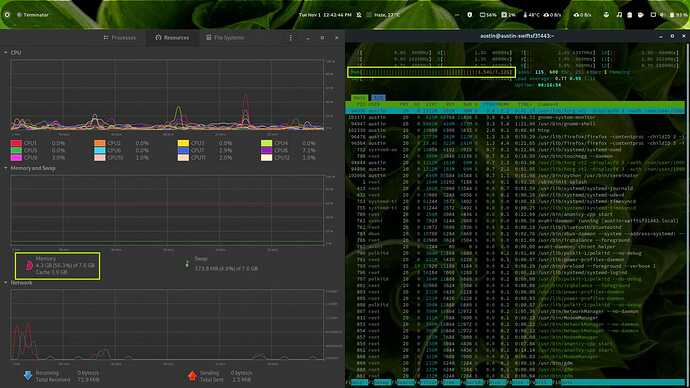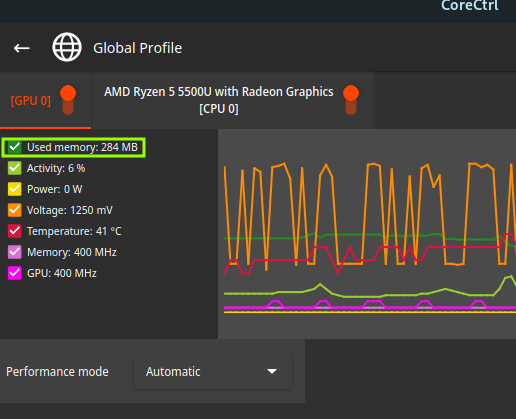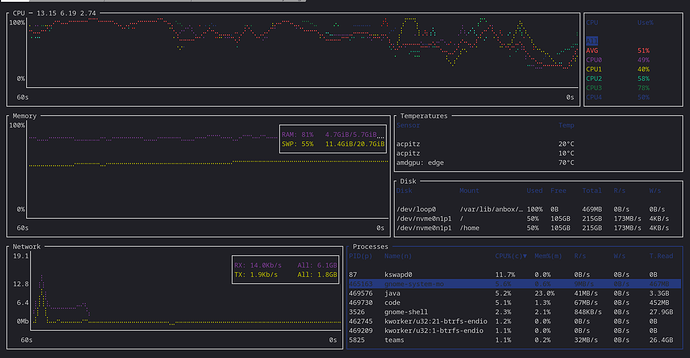Hello,
I think I came here a few months ago, saying that an incorrect amount of RAM had been detected, and one of you guys told me that it was given away to GPU as VRAM. Is it possible to recover that 2GB RAM?
My memory usage on idle is usually between the high 60s and low 80s. I own an HP 15s-gr0xxx, if that matters.
System:
Kernel: 6.0.6-zen1-1-zen arch: x86_64 bits: 64 compiler: gcc v: 12.2.0
parameters: BOOT_IMAGE=/@/boot/vmlinuz-linux-zen
root=UUID=b035583e-b8e2-48c0-87f9-a0552ffa0e5b rw rootflags=subvol=@
splash rd.udev.log_priority=3 vt.global_cursor_default=0 loglevel=3
sysrq_always_enabled=1 resume=UUID=044B5092427CE440
Desktop: GNOME v: 43.0 tk: GTK v: 3.24.34 wm: gnome-shell dm: GDM v: 43.0
Distro: Garuda Linux base: Arch Linux
Machine:
Type: Laptop System: HP product: HP Laptop 15s-gr0xxx
v: Type1ProductConfigId serial: <filter> Chassis: type: 10 serial: <filter>
Mobo: HP model: 87D1 v: 38.25 serial: <filter> UEFI: Insyde v: F.32
date: 08/02/2022
Battery:
ID-1: BAT1 charge: 36.4 Wh (100.3%) condition: 36.3/40.9 Wh (88.7%)
volts: 12.9 min: 11.3 model: Hewlett-Packard PABAS0241231 type: Li-ion
serial: <filter> status: not charging
CPU:
Info: model: AMD Ryzen 5 3500U with Radeon Vega Mobile Gfx socket: FP5
bits: 64 type: MT MCP arch: Zen/Zen+ note: check gen: 1 level: v3
note: check built: 2019 process: GF 12nm family: 0x17 (23)
model-id: 0x18 (24) stepping: 1 microcode: 0x8108109
Topology: cpus: 1x cores: 4 tpc: 2 threads: 8 smt: enabled cache:
L1: 384 KiB desc: d-4x32 KiB; i-4x64 KiB L2: 2 MiB desc: 4x512 KiB
L3: 4 MiB desc: 1x4 MiB
Speed (MHz): avg: 2100 min/max: 1400/2100 boost: disabled
base/boost: 2100/3700 scaling: driver: acpi-cpufreq governor: performance
volts: 1.2 V ext-clock: 100 MHz cores: 1: 2100 2: 2100 3: 2100 4: 2100
5: 2100 6: 2100 7: 2100 8: 2100 bogomips: 33539
Flags: avx avx2 ht lm nx pae sse sse2 sse3 sse4_1 sse4_2 sse4a ssse3 svm
Vulnerabilities:
Type: itlb_multihit status: Not affected
Type: l1tf status: Not affected
Type: mds status: Not affected
Type: meltdown status: Not affected
Type: mmio_stale_data status: Not affected
Type: retbleed mitigation: untrained return thunk; SMT vulnerable
Type: spec_store_bypass mitigation: Speculative Store Bypass disabled via
prctl
Type: spectre_v1 mitigation: usercopy/swapgs barriers and __user pointer
sanitization
Type: spectre_v2 mitigation: Retpolines, IBPB: conditional, STIBP:
disabled, RSB filling, PBRSB-eIBRS: Not affected
Type: srbds status: Not affected
Type: tsx_async_abort status: Not affected
Graphics:
Device-1: AMD Picasso/Raven 2 [Radeon Vega Series / Radeon Mobile Series]
vendor: Hewlett-Packard driver: amdgpu v: kernel arch: GCN-5 code: Vega
process: GF 14nm built: 2017-20 pcie: gen: 3 speed: 8 GT/s lanes: 16
ports: active: eDP-1 empty: HDMI-A-1 bus-ID: 04:00.0 chip-ID: 1002:15d8
class-ID: 0300 temp: 58.0 C
Device-2: Luxvisions Innotech HP TrueVision HD Camera type: USB
driver: uvcvideo bus-ID: 3-2.1:3 chip-ID: 30c9:0035 class-ID: fe01
serial: <filter>
Display: server: X.Org v: 22.1.4 with: Xwayland v: 22.1.4
compositor: gnome-shell driver: X: loaded: radeon unloaded: modesetting
alternate: fbdev,vesa gpu: amdgpu display-ID: :0 screens: 1
Screen-1: 0 s-res: 1920x1080 s-dpi: 96 s-size: 508x286mm (20.00x11.26")
s-diag: 583mm (22.95")
Monitor-1: eDP-1 mapped: XWAYLAND0 model: ChiMei InnoLux 0x153b
built: 2020 res: 1920x1080 hz: 60 dpi: 143 gamma: 1.2
size: 340x190mm (13.39x7.48") diag: 394mm (15.5") ratio: 16:9 modes:
max: 1920x1080 min: 640x480
OpenGL: renderer: AMD Radeon Vega 8 Graphics (raven LLVM 14.0.6 DRM 3.48
6.0.6-zen1-1-zen) v: 4.6 Mesa 22.2.2 direct render: Yes
Audio:
Device-1: AMD Raven/Raven2/Fenghuang HDMI/DP Audio vendor: Hewlett-Packard
driver: snd_hda_intel v: kernel pcie: gen: 3 speed: 8 GT/s lanes: 16
bus-ID: 04:00.1 chip-ID: 1002:15de class-ID: 0403
Device-2: AMD ACP/ACP3X/ACP6x Audio Coprocessor vendor: Hewlett-Packard
driver: snd_pci_acp3x v: kernel
alternate: snd_rn_pci_acp3x,snd_pci_acp5x,snd_pci_acp6x,snd_acp_pci,snd_rpl_pci_acp6x,snd_sof_amd_renoir
pcie: gen: 3 speed: 8 GT/s lanes: 16 bus-ID: 04:00.5 chip-ID: 1022:15e2
class-ID: 0480
Device-3: AMD Family 17h/19h HD Audio vendor: Hewlett-Packard
driver: snd_hda_intel v: kernel pcie: gen: 3 speed: 8 GT/s lanes: 16
bus-ID: 04:00.6 chip-ID: 1022:15e3 class-ID: 0403
Sound API: ALSA v: k6.0.6-zen1-1-zen running: yes
Sound Server-1: PulseAudio v: 16.1 running: no
Sound Server-2: PipeWire v: 0.3.59 running: yes
Network:
Device-1: Realtek RTL8111/8168/8411 PCI Express Gigabit Ethernet
vendor: Hewlett-Packard driver: r8169 v: kernel pcie: gen: 1
speed: 2.5 GT/s lanes: 1 port: 3000 bus-ID: 01:00.0 chip-ID: 10ec:8168
class-ID: 0200
IF: eno1 state: down mac: <filter>
Device-2: Realtek RTL8821CE 802.11ac PCIe Wireless Network Adapter
vendor: Hewlett-Packard driver: rtl8821ce v: N/A
modules: rtw88_8821ce,8821ce pcie: gen: 1 speed: 2.5 GT/s lanes: 1
port: 2000 bus-ID: 02:00.0 chip-ID: 10ec:c821 class-ID: 0280
IF: wlo1 state: up mac: <filter>
IF-ID-1: anbox0 state: down mac: <filter>
Bluetooth:
Device-1: Realtek Bluetooth 4.2 Adapter type: USB driver: btusb v: 0.8
bus-ID: 3-2.3:4 chip-ID: 0bda:b00a class-ID: e001 serial: <filter>
Report: bt-adapter ID: hci0 rfk-id: 1 state: up address: <filter>
Drives:
Local Storage: total: 476.94 GiB used: 125.09 GiB (26.2%)
SMART Message: Required tool smartctl not installed. Check --recommends
ID-1: /dev/nvme0n1 maj-min: 259:0 vendor: Western Digital model: PC SN530
SDBPNPZ-512G-1006 size: 476.94 GiB block-size: physical: 512 B
logical: 512 B speed: 31.6 Gb/s lanes: 4 type: SSD serial: <filter>
rev: HPS2 temp: 51.9 C scheme: GPT
Partition:
ID-1: / raw-size: 200 GiB size: 200 GiB (100.00%) used: 91.92 GiB (46.0%)
fs: btrfs block-size: 4096 B dev: /dev/nvme0n1p1 maj-min: 259:1
ID-2: /boot/efi raw-size: 1024 MiB size: 1022 MiB (99.80%) used: 72.1 MiB
(7.1%) fs: vfat block-size: 512 B dev: /dev/nvme0n1p3 maj-min: 259:3
ID-3: /home raw-size: 200 GiB size: 200 GiB (100.00%) used: 91.92 GiB
(46.0%) fs: btrfs block-size: 4096 B dev: /dev/nvme0n1p1 maj-min: 259:1
ID-4: /var/log raw-size: 200 GiB size: 200 GiB (100.00%) used: 91.92 GiB
(46.0%) fs: btrfs block-size: 4096 B dev: /dev/nvme0n1p1 maj-min: 259:1
ID-5: /var/tmp raw-size: 200 GiB size: 200 GiB (100.00%) used: 91.92 GiB
(46.0%) fs: btrfs block-size: 4096 B dev: /dev/nvme0n1p1 maj-min: 259:1
Swap:
Kernel: swappiness: 133 (default 60) cache-pressure: 100 (default)
ID-1: swap-1 type: zram size: 5.73 GiB used: 4.54 GiB (79.2%)
priority: 100 dev: /dev/zram0
Sensors:
System Temperatures: cpu: 58.4 C mobo: N/A gpu: amdgpu temp: 58.0 C
Fan Speeds (RPM): N/A
Info:
Processes: 385 Uptime: 20m wakeups: 1 Memory: 5.73 GiB used: 4.31 GiB
(75.2%) Init: systemd v: 251 default: graphical tool: systemctl
Compilers: gcc: 12.2.0 clang: 14.0.6 Packages: 1632 pm: pacman pkgs: 1621
libs: 458 tools: gnome-software,pamac,paru,yay pm: flatpak pkgs: 11
Shell: fish (sudo) v: 3.5.1 running-in: kitty inxi: 3.3.22
Garuda (2.6.9-1):
System install date: 2022-10-27
Last full system update: 2022-10-30
Is partially upgraded: No
Relevant software: NetworkManager
Windows dual boot: Yes
Snapshots: Snapper
Failed units: systemd-networkd-wait-online.service



